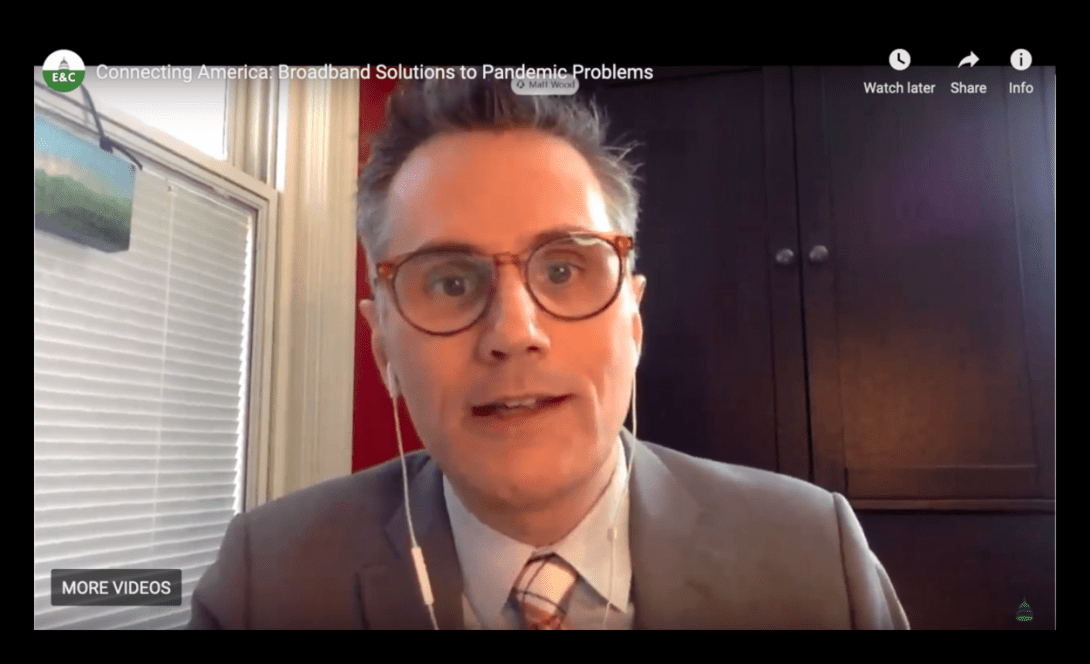77 Million People in the U.S. Lack Adequate Home Internet

Free Press Action VP Matt Wood testified about the need to treat broadband as an essential utility.
How do families stay connected during a pandemic when they can’t afford internet service?
Too often, the answer is simple: They don’t.
That’s what Free Press Action Vice President of Policy and General Counsel Matt Wood told policymakers this Wednesday during his testimony before the House Energy and Commerce Subcommittee on Communications & Technology.
During the COVID-19 crisis, the impacts of the digital divide have become more painfully evident than ever before. Without reliable and affordable internet access, people struggle to attend online classes, work remotely, apply for unemployment, access telehealth services and sign up for vaccination appointments. Those who lack home internet are often unable to safely social distance and are forced to put their entire families at risk to take care of basic human needs.
That’s why it’s even more galling to realize that 77 million people in this country lack access to adequate home broadband. As Wood pointed out in his testimony, the digital divide disproportionately impacts low-income people and people of color: Only two-thirds of people in the bottom income bracket are online, compared to nine out of 10 of those in the top income bracket. While 26 percent of white people lack wired broadband, that number rises to 34 percent for Black people, 35 percent for Latinx people and a whopping 41 percent for Indigenous people.
Why are so many people disconnected? “High prices, plain and simple,” said Wood.
We still need better data about broadband prices, but according to the Bureau of Labor Statistics, average internet bills rose approximately 19 percent in the first three years of the Trump administration. That’s about four times the rate of inflation. And the price hikes were especially steep for lower-cost, entry-level tiers — which are all but disappearing.
That’s why the Emergency Broadband Benefit program is so important. In its last relief package, champions in Congress established a program to offer a $50 monthly benefit ($75 a month for those living on Tribal lands) for low-income families and those who have lost jobs or income due to the pandemic. Recipients can use this benefit toward any broadband plan of their choosing.
During the hearing, Wood expressed strong support for this “landmark, bipartisan achievement”. The program offers flexibility and choice for marginalized households, who too often find themselves shunted into second-class service tiers — or, at the other extreme, upsold to tiers they cannot afford.
Some subcommittee members tried to argue that the broadband market is in great shape, thanks to major network investment spurred by the Trump FCC’s deregulatory fervor — but that’s not true at all.
“The prior FCC chairman didn’t actually spur broadband deployment or decrease prices like he claimed,” Wood pointed out. “In fact, investment declined every year of Chairman Pai’s tenure.”
Ignoring the affordability problem to focus exclusively on deployment is a huge mistake — and one that ignores communities of color and others who are most harmed by the digital divide.
“Even if deregulation alone had increased deployment — and it didn’t — buildout alone would not lower price or increase adoption in the absence of competition, oversight, and more robust adoption subsidies,” Wood said.
To get and keep people connected during this pandemic, we need policymakers to push for competition and affordability measures like the EBB program. And the last thing we need is a mindless drive toward deregulating internet providers in the faint hope that they’ll use these privileges to actually serve the same communities they have long disdained.